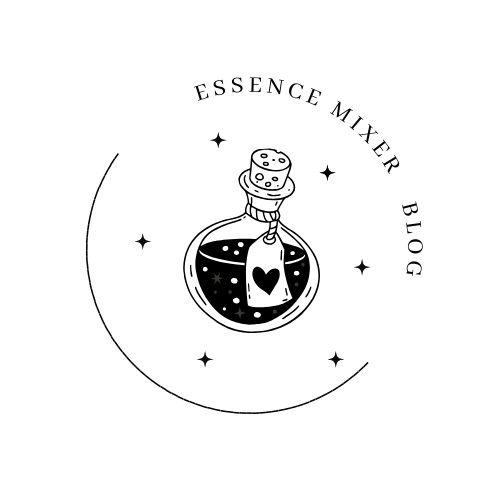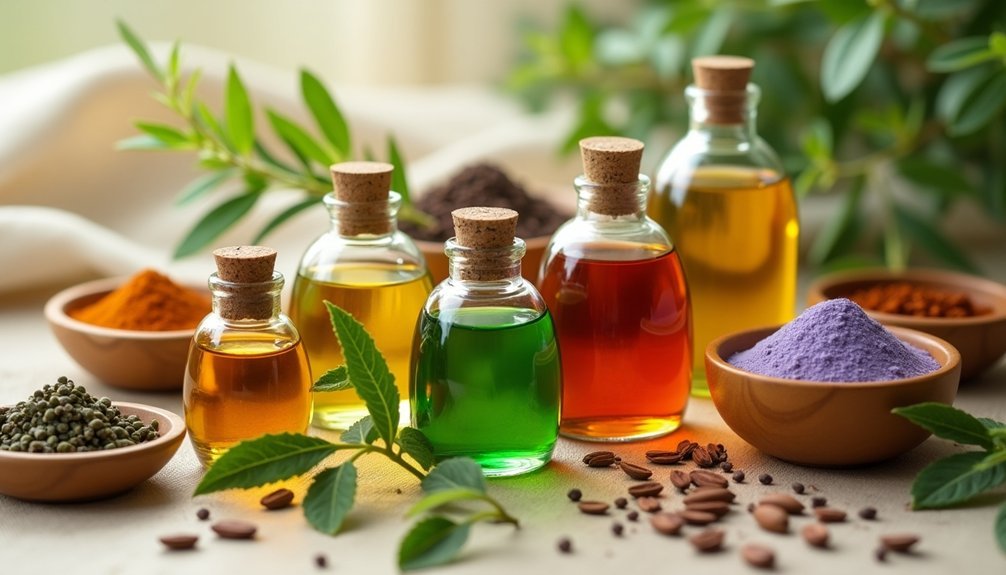When blending aromatherapy fragrances, you'll work with three main families: amber, floral, and woody notes. Amber compositions deliver warmth through vanilla and benzoin, while florals like rose and jasmine form the heart of your blend. Woody essences, including sandalwood and cedarwood, provide a strong foundation. You can create unique therapeutic combinations by following the 30/50/20 ratio rule. Let's explore how these families work together to craft your perfect aromatic harmony.
The Sweet and Smooth World of Amber Fragrances

Amber fragrances envelop you in an enchanting embrace of warmth and luxury. This sophisticated accord isn't a single ingredient but rather a masterful blend of resinous elements that create a rich, cozy atmosphere.
You'll discover layers of vanilla, benzoin, and labdanum working together to produce that signature amber warmth. The ancient tree resin heritage of amber gives it a profound connection to nature's timeless appeal.
When you wear an amber fragrance, you'll experience its evolution on your skin. It starts with sweet, resinous top notes before revealing a heart of honey and spice.
The base notes leave a lasting impression with their sensual, earthy depth. You'll find amber's versatility impressive – it pairs beautifully with florals, orientals, and woody scents.
As a fixative, it helps your fragrance last longer while adding that unmistakable touch of sophistication to any blend.
Floral Notes: Creating Balance in Aromatherapy Blends
While amber fragrances offer warmth and depth, floral notes bring a different dimension to aromatherapy blending – one of elegance, refinement, and emotional resonance.
You'll find most floral oils serve as middle notes, forming the heart of your blends. When working with these delicate yet powerful scents, remember that stronger oils like jasmine require a lighter touch to avoid overwhelming other components. For optimal storage and mixing results, always use dark glass bottles when creating your blends.
- Rose essential oil soothes the spirit and creates romantic atmospheres
- Geranium balances emotions while providing an energetic lift
- Lavender serves as a versatile addition to any floral blend
- Jasmine adds depth and sensuality as both middle and base note
- Ylang ylang brings an exotic, sweet dimension to your creations
Follow the 30/50/20 blending ratio rule, and always test your combinations on perfume strips before finalizing your blend.
Woody Essences: Foundation Elements for Lasting Scents

As the backbone of countless aromatherapy blends, woody essences provide deep, enduring foundations that anchor other fragrance elements.
You'll find classic wood notes like sandalwood, vetiver, and cedarwood offering warm, earthy characteristics that ground your compositions.
When you're creating blends, you can explore different woody subcategories to achieve your desired effect.
Try woody-green combinations for a fresh, natural feel, or opt for woody-amber blends when you want a richer, more luxurious profile.
These versatile scents work equally well in both masculine and feminine fragrances.
You'll discover that woody essential oils excel as base notes, providing staying power to your aromatherapy creations.
Many woody fragrances contain traditional fougere accord for added complexity and depth.
They blend seamlessly with florals, fruits, and herbs while delivering therapeutic benefits of warmth and relaxation.
Frequently Asked Questions
How Long Do Essential Oil Blends Typically Last Before Losing Their Potency?
Your essential oil blends will typically last 2-3 years when stored properly. However, you'll notice citrus-based blends may lose potency within 1-2 years, while those with base notes last longer.
Can Fragrance Allergies Develop From Prolonged Use of Certain Scent Families?
Yes, you can develop fragrance allergies through repeated exposure to any scent family. Your immune system may become sensitized over time, leading to allergic reactions even if you've previously tolerated those fragrances well.
What Temperature Should Essential Oil Blends Be Stored At?
You'll want to store your essential oil blends between 60°F and 70°F (15°C-21°C). It's best to keep them in a cool, dark place or refrigerate them, especially citrus oils, to maintain their quality.
Are Synthetic Versions of Fragrance Notes Safe for Aromatherapy Use?
You shouldn't use synthetic fragrances for aromatherapy, as they can cause health issues like allergies, respiratory problems, and hormone disruption. Stick to pure essential oils for therapeutic benefits and safety.
How Often Should You Rotate Between Different Fragrance Families During Aromatherapy?
You should rotate fragrance families every 2-3 weeks to prevent sensory fatigue. If you're using oils for specific therapeutic benefits, you'll want to adjust rotation based on your current wellness needs.
In Summary
You've now learned the core fragrance families that'll transform your aromatherapy practice. By understanding how to work with amber's warmth, floral's delicate balance, and woody notes' grounding properties, you're ready to create your own unique blends. Remember to trust your nose and experiment with different combinations. Whether you're crafting perfumes or therapeutic blends, these foundations will guide your aromatic journey.





Leave a Reply